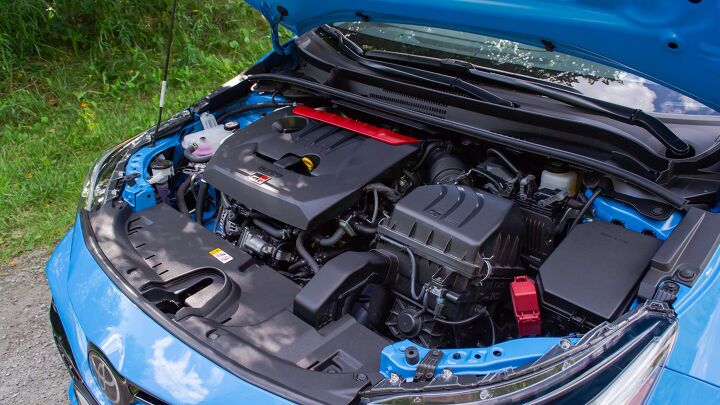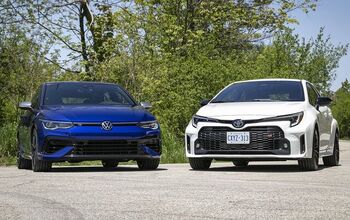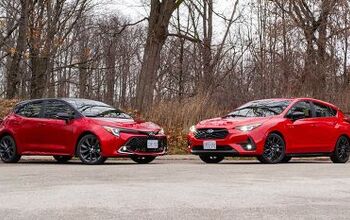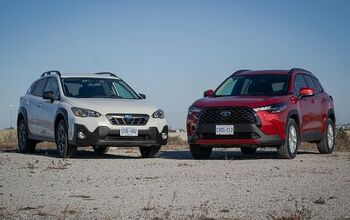Subaru WRX TR vs Toyota GR Corolla Comparison

Imagine how annoyed Subaru must’ve been when the GR Corolla launched.
The company had spent years taming the WRX and STI, keeping that bred-from-rally attitude but mixing in some semblance of creature comforts and livability. Then the STI was no more … and not even a year later, here comes a three-cylinder Corolla that earns praise all over the place for its raucous, slightly unrefined performance. It was raw and as remarkable to drive as the cabin was unremarkable to look at. That was Subaru’s thing, dang it! “ Toyota has built the WRX STI that Subaru wouldn't—or couldn't—build, an everyday hero,” said yours truly a year ago.
Now there’s a WRX TR (or RS in Canada). It doesn’t have the power or adjustable drivetrain goodies of the old STI, but it does promise a sharper drive courtesy of revised suspension settings, Brembo brakes, and other goodies. It’s not a replacement for the ol’ king, but can it bring the current-generation WRX closer to that experience—or at least, close enough to call into question the GR’s elevated price tag? Mike and I had to find out.
Interior and exterior:
WRX TR: The current WRX shape debuted a few years ago, bringing sharper body lines and substantial body cladding. While both are subject to personal preferences, it's safe to say the latter has been somewhat more controversial. The TR doesn't change it up, but the dark blue of this tester does minimize the contrast. New 19-inch alloys are the obvious change here, along with the telltale Brembo rouge behind the spokes. The Subaru as the subtle one? Yes, and that's a story that you'll see repeated throughout this comparison.
Inside, the Scooby has excellent Recaro seats, well-shaped and yet not too aggressive for daily use. The dashboard design is dominated by the large touchscreen; Schlee prefers it since he never much uses phone mirroring, but I'd rather the Toyota's easier access to CarPlay. The GR's screen also doesn't feature a design from the Windows XP days...
Cabin material quality is okay in both cars. The Subaru at least makes an effort to feel special with strips of Alcantara along the dashboard. On the practicality side, its rear seats are more adult-friendly, and while it lacks a hatchback, the trunk is quite large.
GR Corolla: How good is this Blue Flame paint? So good. The Circuit Edition is the only way to get it for 2024, and the combination gives it the sort of shouty presence I can only imagine STI owners enjoy. Stick with a lesser trim and the GR can almost blend in with traffic: the small rear spoiler and lack of hood vents means only the swollen rear arches and triple exhaust are the obvious signs at a glance. It’s not like the GR rolls on oversized wheels either: the 18-inch alloys aren’t any bigger than those on a regular ‘Rolla hatch, and the tires are only slightly wider.
The same-but-different vibe is even stronger in the cabin. There’s no other way to say it: the GR Corolla’s interior is pretty boring. Other than a few gratuitous GR badges, the sport seats, and the shifter—remember, every other pure-gas Corolla now rolls with a CVT—there’s not much to set this apart. It’s all well put together, sure, but this was not the aspect of the old STI we expected the ‘Yota to emulate. The digital instrument cluster is similarly business-like, getting the job done but hardly inspiring.
Cabin space itself is also not the Corolla’s strong suit. If you’ll regularly be sticking adults in the rear, which isn’t an unreasonable task for a daily driver, the GR’s relatively tight confines do it no favors.
Powertrain and driving dynamics:
WRX TR: When the latest generation WRX was launched, many criticized it for only gaining a few horsepower. But the changes are deeper than just the numbers. With a larger 2.4-liter turbocharged four-cylinder under the hood, usable torque has gone way up.
The271 hp on tap feels much more robust than the last generation WRX, which needed to be in the higher rpms to really come alive. The GR Corolla is easily the quicker vehicle, but the WRX TR is better suited for everyday driving. The clutch uptake requires minimal revs to engage, and higher gears can be used at slower speeds compared to the Toyota.
The upgrades to the TR center around much larger braes, which has always been a Subaru WRX weak spot. The extra pistons and larger rotors make stopping much more linear with a firmer pedal feel. The other key upgrade is to the suspension which is tuned to better control body motions.
Although the new suspension is stiff in terms of ride comfort, it is not on par with the old STI when it comes to cornering ability. This is not the STI's suspension, nor does the WRX offer the discontinued cars’ selectable DCCD center differential or limited slip differentials. That stated, the WRX does corner well, but it’s not nearly as planted, or willing to rotate through corners, as the Toyota GR Corolla.
GR Corolla: One hundred horsepower per cylinder. That’s quite an accomplishment, and to achieve it, the GR Corolla’s little 1.6-liter relies on a whole lot of boost. It’s properly old-school in its delivery, too: you’ll catch the ‘Rolla sleeping before 2,500 rpm, but it wakes up soon after, and chugs a Red Bull by 4,000 rpm. After that it’s a rip to redline with no signs of slowing down. The six-speed shifter isn’t the best example in the segment, but it’s sharper and has more definition than the rubbery setup in the WRX. The clutch is friendly with a well-defined bite point, and the pedals are well-spaced for heel-toe action. Not feeling it? The switchable rev-matching works very well.
I love that the GR doesn’t even try to hide its turbo nature, gleefully wooshing and hissing all over the place. The soundtrack out of those three tips is strong and bassy; not the prettiest, but like Buckley’s cough syrup, it just works.
The Corolla’s smaller footprint makes it the nimbler, more chuckable car through our windy test route. Take advantage of the GR-Four drive select dial, apportion more power to the rear axle, and this is the slideways-iest Corolla since Initial D. Not only that, but the Corolla’s steering has just a bit more feel and feedback, though both cars respective helms are too light in this writer’s opinion. The brakes might lack the Brembo name, but they’ve got good bite and are easily modulated.
Ride quality is an interesting contrast to the WRX. The ‘Rolla rolls on smaller wheels, so it has more sidewall to cushion the car from the worst surface-level bumps. The ride is stiff but not aggressively so, allowing the car to still telegraph its limits well while retaining a reasonably comfortable ride on the highway. It’s just all so loud. The Corolla cabin brings the noise, and there’s so little isolation that the rearview mirror vibrates between 2,000 to 4,000 rpm.
Value:
WRX TR: American buyers can expect a $42,775 price tag attached to a WRX TR, including destination. That puts it right in the middle of the GR Corolla lineup: you can get the Premium for slightly less than this, and while it lacks the looks, it should still satisfy on the road.
Canada’s pricing makes the GR a very tough sell. The WRX RS is somehow just $43,990 CAD; nearly five grand below the starting price of the ‘Rolla. The as-tested gap is nearly triple that. Ouch.
GR Corolla: Provided you can actually find one, the basic GR Corolla Core model lists for $37,635 in America, including destination. You get the same basic goodies as this Circuit Edition, including the GR-Four drive select dial, though paired off with demure looks and a cloth-trimmed cabin. Stock, the GR Core comes with open diffs, but buyers can add them as part of an options package. This Circuit Edition tester would retail for $46,275. It’s nice, but is it $8,600 nicer? Probably not.
In Canada, the Core’s option pack is standard, which explains the comparatively high $48,610 CAD starting price—already more than the WRX RS in the Great White North. Yet the Circuit is a full five-figure upgrade, bringing the damage to $58,710 CAD. Oof.
Verdict: 2024 Subaru WRX TR vs 2024 Toyota GR Corolla Comparison
I’m not going to sugar-coat it, Scooby fans: the GR Corolla effectively picks up the torch the STI has left behind. It’s a little monster, a slightly rough-around-the-edges hot hatch that puts all its considerable efforts behind making you giggle. Toyota’s made a great one here.
But in Canada, that price gap is simply prohibitive. Is the GR Corolla really worth over 30-percent more cash than the WRX, if you’re looking for the STI experience? No. The TR still ain’t an STI replacement, but it comes reasonably close considering the cost, and makes the WRX better suited for further tuning or the occasional track day (or both). If budget is a concern, go with the TR and you’ll get great value for money. Just skip even test driving the GR; then, you won’t know what you’re missing.
Become an AutoGuide insider. Get the latest from the automotive world first by subscribing to our newsletter here.

Kyle began his automotive obsession before he even started school, courtesy of a remote control Porsche and various LEGO sets. He later studied advertising and graphic design at Humber College, which led him to writing about cars (both real and digital). He is now a proud member of the Automobile Journalists Association of Canada (AJAC), where he was the Journalist of the Year runner-up for 2021.
More by Kyle Patrick









































Comments
Join the conversation